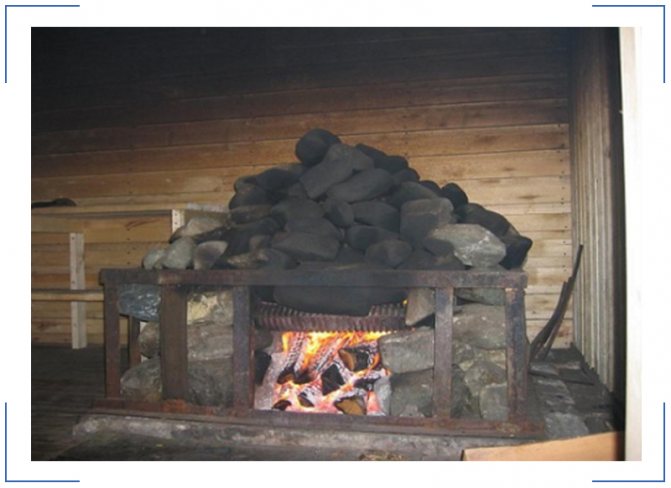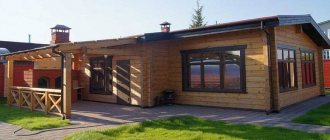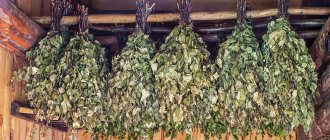Rural and urban baths
In fact, the ban applied only to city public baths. In rural areas, baths were private, usually in the form of extensions to huts, and peasants washed in them, as a rule, only their family.
Moreover, in the “first couple” men and children went to wash, then women. Public baths were most often built on the banks of the river, so that there was somewhere to plunge after the “steam”. Inside, the one-story building was divided into a dressing room, a soap house and a steam room. It was in such baths that citizens of all genders and ages actually washed together.
History of the Russian bath
The building is considered one of the oldest in Rus'. According to historians, its appearance coincides in time with the emergence of the Slavs as a separate ethnic group. It is believed that the bathhouse combines all four elements: water, earth, fire and air. According to the legends of our ancestors, after visiting the “Movni”, a person became stronger in spirit and body. The Slavs firmly believed in the healing and cleansing “talents” of the baths.
Before making an important decision or before setting off on a long journey, a person always went to take a steam bath. The offer to visit a hot bathhouse subsequently became a symbol of Russian hospitality.
The bathhouse in Rus' is a favorite pastime for all segments of the population; aristocrats and simple peasants were not averse to taking a steam bath. Anyone who had a piece of free land at their disposal could erect a building. In the mid-seventeenth century, a decree was issued that the construction of baths should be carried out at a distance from residential buildings. Most likely this was a kind of fire safety measure.
Over time, in addition to private baths, public baths began to be built, where anyone could wash for a certain amount. The most popular “soaphouses” are the Sandunovskie baths, built in 1808 and still functioning today.
"Hotbeds of debauchery"
Common baths, where men and women presented themselves to each other in the clothes their mother gave birth to, seemed to the church authorities to be a “breeding ground for debauchery.” The first attempt to prohibit joint washing was made in Stoglav in 1551.
In 1646, a decree was issued “so that in Nizhny Novgorod men and wives should not steam together in trading baths,” and on December 21, 1741, a decree of the Governing Senate was issued, which stated: “... in Moscow and in other cities, men and wives steam in special baths, not together.” But the authorities' orders were not followed.
“To the credit of the Russian people, joint visits to public baths by men and women had only a very limited sexual connotation, which manifested itself only in jokes (sometimes very obscene), flirting, but nothing more serious,” writes Andrei Dachnik in the book “Bathhouse. Essays on ethnography and medicine.”
The healing effects of the Russian bath
The healing properties of the steam room have been known since ancient times. If washing lasts more than thirty minutes, the growth of blood cells is activated by twelve percent, and the level of hemoglobin in the blood increases.
The steam room helps improve metabolism. If you make a list of pathologies that a bath helps to cope with, you will get a very impressive list. A visit to the soap shop is recommended for gout, rheumatism, and scrofula. It helps fight excess weight well.
Doctors recommend regular visits to the bathhouse for those who suffer from blood stagnation in the liver and spleen. The steam room also helps with bone pathologies and intestinal ailments. This is just a minimal list.
| There are also contraindications to visiting the bathhouse. You should not visit the soap shop if you have tuberculosis or heart defects. Pregnant girls at risk of miscarriage will also have to avoid the steam room. |
Since the production of gastric juice decreases at high temperatures, you should not go to the bathhouse for four hours after eating.
The steam room cleanses of toxins. The human body regularly accumulates harmful substances that are released at high temperatures.
Shock for foreigners
On the other hand, Russians washing together in baths shocked foreigners. Here is the testimony of Baron Augustine Mayerberg, the ambassador of the Roman Emperor Leopold at the court of Tsar Alexei Mikhailovich, left in 1661: “In public baths there are also women of ordinary rank in large numbers; but although they wash there separately from the men behind a partition, yet completely naked people enter the same door with them, and if such a desire comes to someone, she will stop at her threshold, and she is not ashamed to talk in front of strangers with her husband who is washing, with the most absurd chatter.
Yes, even they themselves, having drawn blood in the same way as their husbands, by cutting and lashing to the very skin, also run to the nearby river, mingling with the men and not at all considering it important to expose their nakedness, which arouses lusty, to their insolent glances.”
Dutch sailing master Jan Struys, having visited Moscow in 1669, testified: “Public baths are used by men and women, young and old, without distinction. Having stripped naked, everyone enters the same door, sometimes covering their shame with nothing more than bunches of dried birch branches, with which they rub the body, having previously sprinkled water on it, which happens when they steam on the benches... So, men and women, young and old people run out of the bathhouse without shame or fear, so that everyone can see them..."
Brought up in strict rules and suspicious of washing, foreigners categorically refused to wash in such conditions and demanded the construction of special baths in the German settlement, where men and women washed separately.
Traditional Russian bath
“Movnya” of our ancestors is an example of minimalism and maximum ergonomics. The private bathhouse was an ordinary wooden frame, equipped with a small window, which was located almost under the ceiling.
The cracks between the logs were caulked using moss and tree resin. With the help of such manipulations, it was possible to achieve relative tightness and thermal insulation in the room.

In the corner of the bathhouse there was a huge stove-stove, which was considered the main element of the interior. Stones were laid on top of it, with the help of which the optimal temperature was maintained for a long time.
There was also a container filled with clean water in the room. After the cobblestones became hot, the fire was extinguished, and water was splashed onto the stones from a wooden ladle. There were shelves along one of the walls; they were chosen depending on the desired temperature regime. The higher you go, the hotter the air. Only experienced steamers risked climbing to the topmost ones, because the temperature there could reach one hundred degrees.
Usually baths were built near reservoirs; after the steam room, people ran out into the street and jumped into a lake or river. The maximum effect could be achieved in winter due to the large difference in temperature. If it was not possible to place a log house near a reservoir, then water from a well was used for dousing.
| For the construction of baths, only wood was used, and of different types. Each type of wood emitted a wonderful aroma, adding a special chic to the bath procedures. |
Logging and clay preparation
timber for the bathhouse all summer in advance (a year in advance) for construction . We usually went to Tereshka to get it: there was a lot of oak growth there. The logs were sanded and dried. That is, by the time the construction of a log bathhouse began, the main material was fully prepared by the future owner of the bathhouse.
Red clay was brought in wagons from a pit outside the village. It was soaked in water in the evening and crushed together with hay chaff in a circle. If there was a horse, then it kneaded: some kid would sit on the horse and drive it around in a circle, and the men would add clay, water and chaff to the circle as needed.
When the owner was unable to take a horse from the stable, boys and girls of 10-12 years old climbed into the circle. It was a lot of fun: the kids were running back and forth in a circle, pushing each other, throwing clay. And the clay from their fuss wrinkles and becomes elastic. Knead the clay 2-3 times. It was not in vain that the parents sent the children to this work. All the bumps and cracks on the children’s legs from the greasy clay immediately disappeared when dancing in a circle. So the benefit is double: the clay is crushed and the legs are healed. Cover the finished clay with rags overnight so that it sours and does not dry out.
Calling neighbors to a construction site
That same evening, the owner of the construction site walked around the village among his neighbors and called them for help (in the village they said “to help”). None of the invitees ever refused: someday you will have to build yourself: if you don’t go now, who will help later? So everyone who was not sick, from young to old, gathered, everyone who could help in any way.
The village had a soldier's field kitchen. She roamed around all the yards as needed. The owner of the construction site asked her neighbors who had this kitchen now. One of them must have known, and the children skipped, accompanied by the hostess, rushing behind the kitchen.
What did they do in the bathhouse in Rus'?
The Russian bathhouse was first mentioned in The Tale of Bygone Years. This is the 10th century. But some historians believe that the bathhouse appeared in Rus' much earlier, in the 5th–6th centuries.
Since ancient times, it has been considered a sacred place where four elements simultaneously dominate: water, fire, earth and air. They cleanse a person not only physically, but also spiritually.
The Russian bathhouse is fundamentally different from European and Asian ones - in terms of high heat and such an integral attribute as a birch broom. The Russian bath ritual shocked visiting foreigners, who called the action taking place torture and self-torture.
When the British came to Rus' through the North, they noted that these barbarians drowned huts “in black”, then families bathed in them, torturing each other with twigs, and then, whooping, threw themselves into a river or pond.
The first Russian baths were black-style baths. There was a stove without a chimney. Smoke and soot went directly into the steam room. The walls and ceiling instantly became smoky and black—which is what gave these baths their name.
They steamed in them only after they had been well ventilated. They opened all the windows and doors to let the smoke escape. Later they began to install stoves with a chimney. And such baths were called white. They also steamed in Rus' in ordinary home ovens. They had spacious mouths - almost one and a half meters deep and about half a meter high. After cooking, the ash was removed from the warm oven, the soot was washed off, and straw was laid. They put a tub of hot water to sprinkle the roof of the stove, climbed inside, lay down and steamed.
In Rus', everyone used the bathhouse: princes, noble people, and ordinary people.
Not a single celebration was complete without a bathhouse. So, after the birth of a child, this event had to be “washed” in a bathhouse. The wedding ceremony was not complete without it. On the eve of the wedding, the bride and her friends went to the bathhouse. Accordingly, the groom and his friends visited the steam room. The day after the wedding, the newlyweds also went to the bathhouse. Upon leaving it, they were met by the matchmaker and treated to fried poultry and “bannik” - bread with which the mother of the bride blessed the newlyweds for the crown.
Foreigners were amazed that Russians preferred the bathhouse as a place of communication. As Courlander Jacob Reitenfels wrote, “Russians consider it impossible to form friendship without inviting them to the bathhouse and then eating at the same table.”
Almost every house in Rus' had its own bathhouse, which was heated once a week. Saturday was considered a bath day. Even public offices were not working. The construction of baths was allowed to everyone who had enough land. A decree of 1649 ordered “soaphouses to be built in vegetable gardens and in hollow places not close to the mansion” to avoid fires. The whole family washed themselves in home baths. Olearius (German scientist 1603-1671), who traveled to Muscovy and Persia in 1633-1639, wrote that “Russians can endure intense heat, from which they become all red and become exhausted; that they are no longer able to stay in the bathhouse, they run naked into the street, both men and women, and douse themselves with cold water, but in winter, running out of the bathhouse into the yard, they roll in the snow, rub their bodies with it, as if with soap, and then go to the bathhouse again.”
However, nobles and rich people gave preference not to home baths, but to large public baths, where people of all ages and genders also steamed and washed together. Many “enlightenment” and “moralists” of that time called public baths the main hotbed of debauchery. Although in Europe at that time, washing men and women together was common.
But the freedom of morals and relationships that reigned in Russian baths surprised foreigners. In their opinion, the Russians were completely devoid of the false modesty inherent - as they said - in every civilized (that is, European) person. Families with small children came to the baths. Here, in the common room, walking girls called rubbing girls worked. There were separate rooms and nooks for wealthy clients of all classes.
Only after the Decree of Catherine the Great was joint “washing” prohibited. In 1743, the baths were divided into women's and men's. By the 19th century, expensive, richly furnished bathhouses with good service and excellent buffets appeared in large cities.
But the most famous and luxurious were the Sandunovsky baths in Moscow. The entire elite of the Russian nobility visited this bathhouse and where foreigners began to go with pleasure.
In 1992, Sanduny was declared an architectural monument and taken under state protection. Russian steam baths did not take root abroad. But sometimes in Europe you can see a sign with the name of a place containing the word banya.











